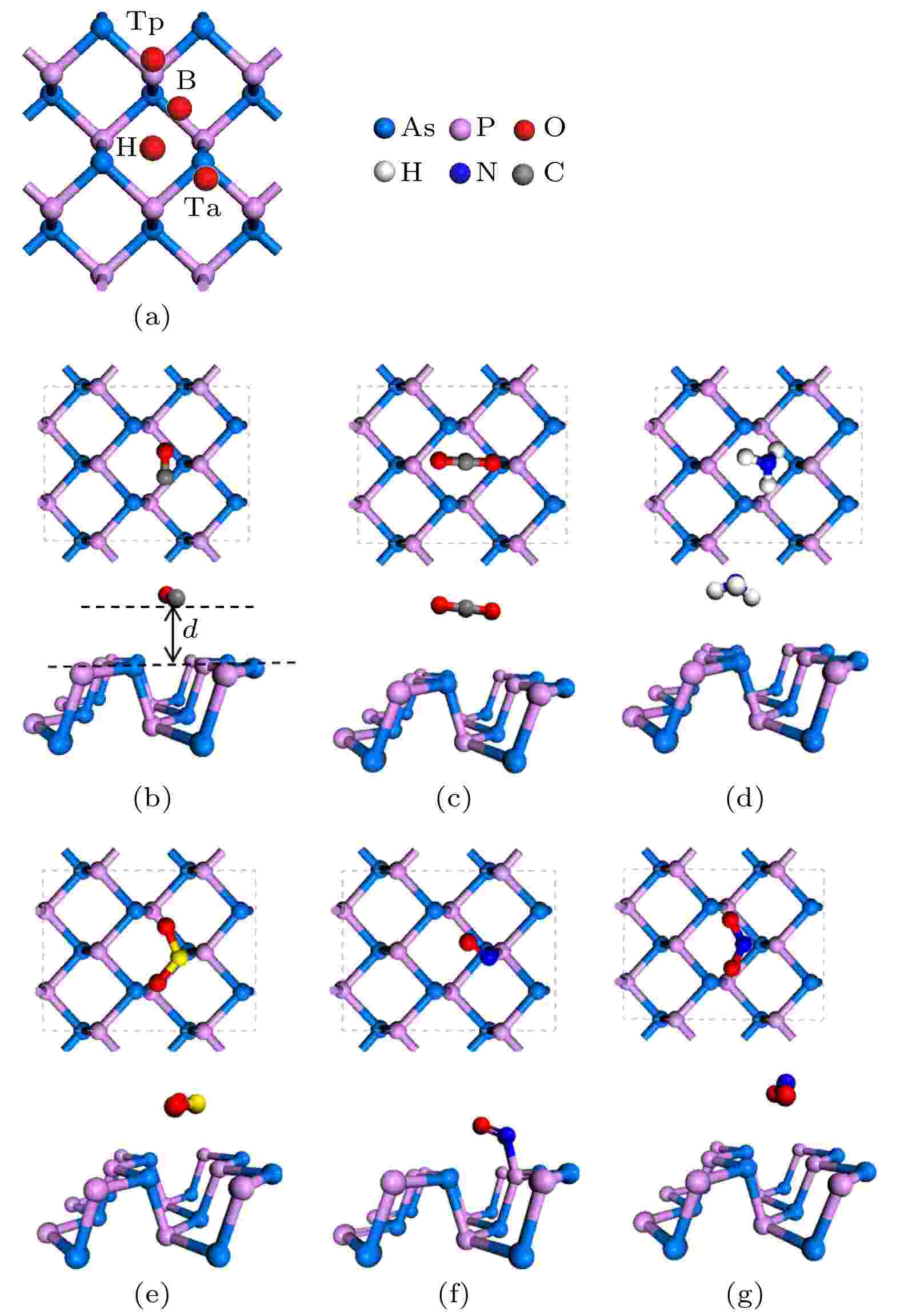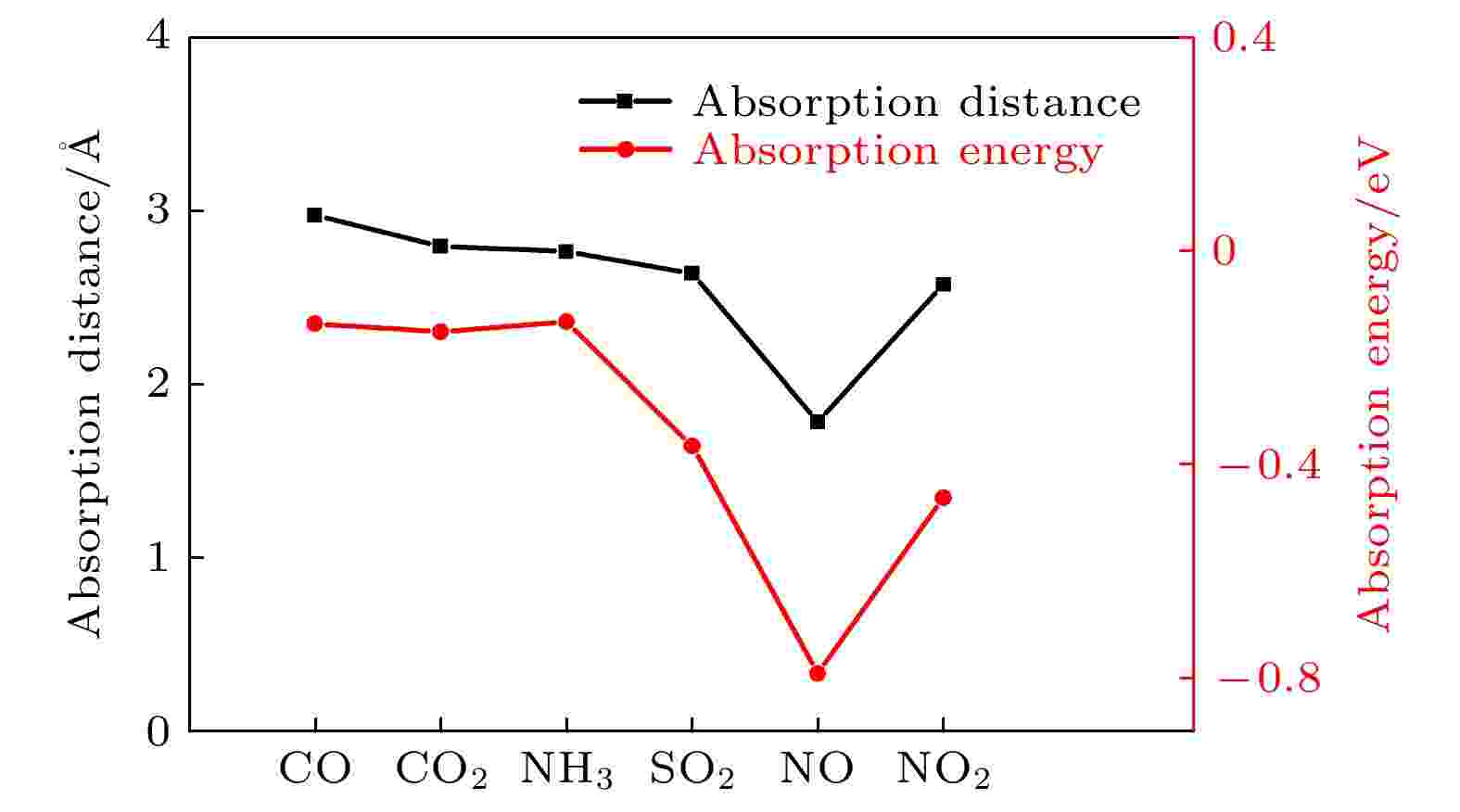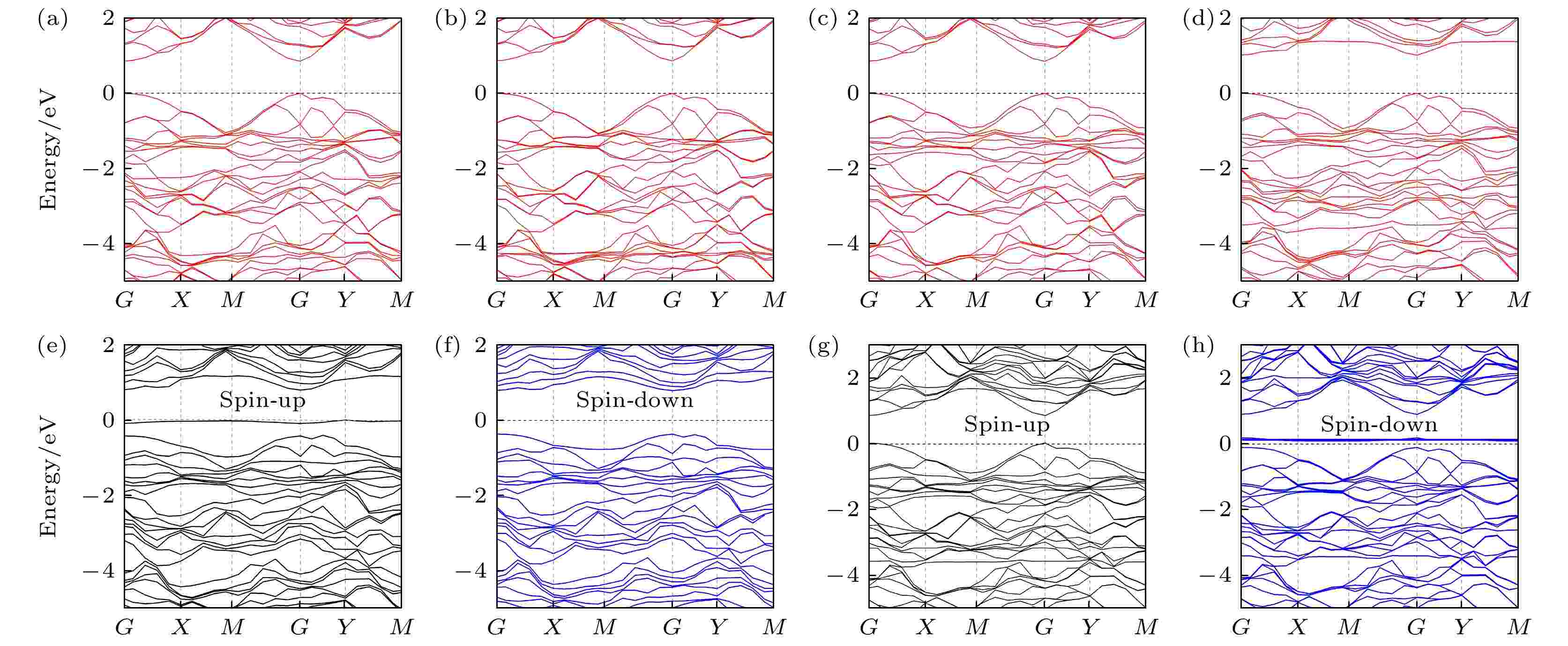全文HTML
--> --> -->二维纳米材料由于其较大的比表面积、高载流子迁移率和低功耗成为气敏传感器的理想材料. 自从2004石墨烯发现以来[10], 研究员们就对二维材料的气敏特性开展了广泛研究, 发表了许多关于二维材料石墨烯或过渡金属二硫化物(transition metal disulfides, TMDs)的气体吸附性工作的文章[11-14]. 然而石墨烯固有的零带隙的特性限制了它作为气敏材料的响应灵敏度[15]. 过渡金属硫化物[16,17]也因为相对较低的载流子迁移率同样受到限制. 这促使科学家们去寻找更多性能优越的新型二维材料. 近些年一种新型二维纳米材料—单层黑磷(也称磷烯)[18-22]受到很多关注. 适中的直接带隙、高的载流子迁移率(300—1000 cm2·V–1·s–1)使它有希望成为最具潜力的气敏材料. 单一的磷烯吸附气体种类有限, 随着研究人员将IV—VI族元素引入磷烯[23-25], 极大拓展磷烯气体传感方面的应用. 但一直以来关于V族元素引入的研究较少, 那V族引入会产生什么样的影响呢? 进一步研究后, 研究员提出了一种类磷烯的新型二维材料黑磷砷(AsP). 作为磷烯与砷烯的V-V单层化合物, 它具有丰富的物理和化学性质[26-31]. Liu等[32]和Krebs等[33]采用合金化方法在实验中成功合成出黑磷砷. 黑磷砷与黑磷一样具有“褶状”的表面结构, 适中的带隙宽度[34]和很高的载流子迁移率(约14380 cm2·V–1·s–1)[35], 而且它能与许多原子发生强烈反应并能保持自身完整性[29]. 目前为止, 有关二维材料黑磷砷的气敏特性尚不明确, 因此有必要进一步研究黑磷砷对气体小分子的吸附特性.
本文通过密度泛函理论(density functional theory, DFT)计算, 研究了六种气体—CO, CO2, NO, NO2, NH3和SO2在单层黑磷砷上吸附的性能. 首先确定气体分子在单层上的最佳吸附点, 计算了各个气体分子的吸附能和吸附距离. 通过分析基底和气体之间的电荷转移进一步了解吸附的机理. 最后研究气体吸附对于单层AsP的电学性质和磁学性质的影响. 研究结果表明, 二维材料黑磷砷(AsP)在气体传感器上有广阔的应用前景.
优化后的超胞模型如图1(a)所示, 计算得到晶格参数为a = 3.47 ?, b = 4.68 ?, 与文献[31]结果基本一致[31]. 从图1(b)能带图可以看出AsP为直接带隙半导体, 导带最低点和价带最高都位于G点. 禁带宽度为0.874 eV, 因为PBE函数会低估禁带宽度所以我们又采用了Heyd-Scuseria-Ernzerhof (HSE06)[42]方法来校正计算. 结果为1.65 eV[30], 确保了模型的正确性.
 图 1 (a)黑磷砷的顶部和侧面图; (b) 本征黑磷砷的能带图
图 1 (a)黑磷砷的顶部和侧面图; (b) 本征黑磷砷的能带图Figure1. (a) Illustration of top and side view of AsP monolayer; (b) electronic band of pristine AsP.
吸附能可以表明不同气体吸附在黑磷砷表面的吸附强度, 把吸附能Ead定义为
气体传感器的工作原理是当气体吸附在敏感材料上, 气体与材料表面会发生电荷转移, 造成电阻率变化, 从而引起电流变化, 实现检测. 电阻率σ与能带关系如下式所示:
恢复时间τ是指气体从材料表面脱附时间, 因为气体传感器需要重复使用, 从而恢复时间的快与慢是衡量一个气体传感器的重要指标. 恢复时间的定义为
3.1.结构性质
对于每种吸附的气体, 考虑了4个吸附点来获取它最为稳定的吸附位置. 如图2(a)所示: 1) Ta位代表As原子上方; 2) Tp位代表P原子上方; 3) H位代表四边形中心的上方; 4) B位代表P和As原子键上方. 图2展示所有最优的气体吸附位置, 气体吸附距离和吸附能都呈现在图3. 对于CO分子吸附, CO分子键倾斜而且碳原子更靠近基底材料表面, CO吸附距离是2.98 ?. CO2和CO情况类似, 最优吸附位在H位, 吸附距离是3.3 ?. 由于这两种碳氧气体吸附距离都在3 ?左右, 可以判断这两种气体吸附属于弱范德瓦耳斯吸附. AsP表面和气体分子相隔很远, 气体分子容易脱离吸附. 其次就是3个比较强的物理吸附体系, 分别是NH3, SO2和NO2气体. 相比于碳基分子, 这三种气体吸附距离小, 与基底材料表面吸附相对稳定. NH3气体最佳吸附位在H位, 3个氢原子朝下, 吸附距离为2.77 ?. SO2气体平行地吸附在四边形中心偏右位置, 其中有1个O原子微微朝下, 吸附距离为2.64 ?. NO2吸附在H位点偏右, 两个O原子比N原子更靠近AsP表面. N原子相比O原子表现更偏向基底P原子, 可能是其和P原子具有更强相互作用有关. NO2气体的吸附距离为2.58 ?, 仅次于NO气体. NO气体分子吸附在AsP表面P原子上方(Tp位), 分子键倾斜, 其中N原子和AsP中的P原子发生强烈反应, 形成一个新的化学键. NO气体的吸附距离为1.79 ?, 可以确定NO气体以化学吸附形式吸附在AsP表面. 从上述结果可知, 氮硫气体的吸附距离相比其他气体数值更小, 吸附更稳定. 除了NO气体, 其他气体都为物理吸附. 图 2 (a) 4个不同吸附点位图; (b) CO, (c) CO2, (d) NH3, (e) SO2, (f) NO, (g) NO2气体在单层AsP上的吸附图
图 2 (a) 4个不同吸附点位图; (b) CO, (c) CO2, (d) NH3, (e) SO2, (f) NO, (g) NO2气体在单层AsP上的吸附图Figure2. (a) Schematic diagram of four different absorption sites; the most favorable configurations of monolayer AsP with (b) CO, (c) CO2, (d) NH3, (e) SO2, (f) NO and (g) NO2 absorption.
 图 3 CO, CO2, NH3, SO2, NO, NO2与单层AsP之间的吸附距离和吸附能
图 3 CO, CO2, NH3, SO2, NO, NO2与单层AsP之间的吸附距离和吸附能Figure3. Absorption distance and absorption energy for CO, CO2, NH3, SO2, NO and NO2 on AsP monolayer.
吸附能如表1所列, CO, CO2和NH3吸附强度普遍不高, 都在0.13 eV左右. 而NO分子在AsP表面的吸附强度最高, 达到0.79 eV. SO2吸附强度居中, 为0.363 eV. 从图3可以观察到, 吸附强度与吸附距离存在某种联系即: 吸附距离越小, 吸附能就越小(吸附强度越大). 从结果来看AsP对于氮氧类气体更敏感. 在基于磷烯[43]和砷烯[41]的气敏性的研究中, 也发现相比磷烯对CO, CO2, NO, NO2的吸附能(–0.3 eV, –0.36 eV, –0.8 eV, –0.6 eV), 二维材料AsP保留对氮氧类气体较高气体吸附强度, 降低了对其他气体的敏感度, 这极大提高了AsP对气体分子选择性. 此外本文通过计算发现黑磷砷对于空气中的N2, O2和H2O的吸附能较低(在0.15 eV附近), 这表明这些气体对黑磷砷吸附影响很小.
| 气体 | Ead /eV | ρ/e | Spin/ μB | τ/s |
| CO | –0.135 | –0.03 (0.02) | 0 | 1.8 × 10–10 |
| CO2 | –0.156 | –0.01 (–0.04) | 0 | 4.03 × 10–10 |
| NH3 | –0.131 | –0.02 (–0.04) | 0 | 1.5 × 10–10 |
| SO2 | –0.363 | –0.15 (0.05) | 0 | 1.2 × 10–6 |
| NO | –0.79 | –0.21 (–0.20) | 0.83 | 15.7 |
| NO2 | –0.46 | –0.14 (–0.01) | 0.78 | 4.8 × 10–5 |
表1不同气体吸附的吸附能、转移电荷数量、气体分子的磁矩和恢复时间, 括号里数值是与Mulliken分析法对比的结果
Table1.The absorption energy (Ead), the charge transfer from basic material to gas molecule (ρ), the local magnetic on gas molecule (Spin) and the recovery time (τ) for gas desorption from material. The values in brackets are the results of comparison with Mulliken analysis.
2
3.2.电荷转移和恢复时间
吸附能大小决定的是气体分子在材料表面的稳定性, 而基底与气体之间的电荷转移数量与材料对气体的敏感性有着密切的联系. 一般来说, 转移电荷越多, 气体与基底材料相互作用就越强烈, 材料对气体分子敏感性越好. 电荷转移的数值在表1中列出, 转移电荷为负值表明电子从基底材料转移到气体分子上. CO, CO2和NH3这三种气体分子的转移电荷量要比NO, NO2气体小1个数量级, 大致在0.03e左右, 这说明三种气体与AsP相互作用并不强烈, 这和它们较大的吸附距离相符. SO2接受电子有0.15e, 说明SO2与AsP相互作用明显. 但从表1吸附能可知, SO2吸附后整个体系不如氮氧气体吸附时那么稳定. NO和NO2的电荷转移最多, 其中NO的转移电荷数量最高(为0.21e). 这表明氮氧气体与AsP的相互作用强烈. 结合电荷转移数量以及吸附强度发现: 电荷转移越多, 相应的吸附体系的吸附强度越强(吸附能越小). 从电荷转移的角度, 或许可以进一步了解气体分子吸附在AsP表面的吸附机理.对于AsP来说, 当气体分子吸附到材料表面后, 电子从AsP表面转移到气体分子上, 导致AsP的表面电荷减少, 影响材料阻值进而引起电流变化, 通过电信号变化可以判断待测气体的相关信息. 综上, 当气体分子吸附在材料表面后, 材料表面会发生一定数量的电荷转移从而影响到气敏材料的阻值. 而且电荷转移数量直接反映出AsP对不同气体的吸附性能. 这也说明了为什么NO, NO2气体吸附在AsP表面上表现出很高的吸附强度.
恢复时间τ是气体传感器的一个重要参数. 一个气体传感器必须具备可重复性, 这就要求它的恢复时间即气体从敏感介质上脱附的时间要相对短暂. 假设气体都是在室温中进行, 从(3)式可以得到所有气体的恢复时间, 具体数据都列在表1中. 在室温下, CO2, CO和NH3的恢复时间都在ns级, 时间短暂, 但根据求得的转移电荷数量可知, 这三种气体与AsP之间作用力很弱, 所以气体脱附也很容易. 因此, AsP不适合检测这三种气体分子. SO2和NO2气体分子和AsP相互作用明显, 它们的恢复时间分别是1.2 μs和0.48 μs. AsP对NO的吸附能最高, 达到–0.79 eV, 室温下NO的恢复时间约为15.7 s. 因为吸附能很强使得脱附时间大大增加, 但相对来说还在接受范围以内. 从恢复时间角度, AsP是很有潜力的SO2, NO和NO2气体传感器.
2
3.3.电子结构
除了分析电荷转移数量, 探究气体吸附后基底材料电学性质的变化同样可明晰材料对于气体敏感程度. 通过能带图和态密度图可以清楚地展示材料电子结构的变化. 图4是各种气体分子吸附后的能带结构图, 图5为不同气体吸附后的总态密度(TDOS)与分波态密度(PDOS)曲线. 当CO, CO2和NH3气体吸附在AsP表面上, AsP的禁带宽度变化很微弱, 这说明CO, CO2和NH3气体与AsP之间的相互作用不强, 与它们低的吸附能相符. 从图5态密度图也能看出, 与本征的TDOS图相比这三种气体吸附后变化不大, 只有一些波峰的峰值增加. 通过对比TDOS图和PDOS图可知, 这些峰值增加是由C, N, O, H的p轨道贡献的, 但这些峰值变化对于二维材料AsP的电学性质影响很小. 图 4 (a) CO, (b) CO2, (c) NH3和(d) SO2吸附在单层AsP表面的能带结构; (e), (f) NO和 (g), (h) NO2吸附在单层AsP表面的能带结构图, 其中黑线和蓝线分别表示自旋向上和自旋向下的能带结构
图 4 (a) CO, (b) CO2, (c) NH3和(d) SO2吸附在单层AsP表面的能带结构; (e), (f) NO和 (g), (h) NO2吸附在单层AsP表面的能带结构图, 其中黑线和蓝线分别表示自旋向上和自旋向下的能带结构Figure4. Band structure of (a) CO, (b) CO2, (c) NH3 and (d) SO2 absorbed on AsP monolayer; the band structure of (e), (f) NO and (g), (h) NO2 absorbed on AsP monolayer, where the black and blue line represent the band structure of spin-up and spin-down, respectively.
 图 5 (a) CO, (b) CO2, (c) NH3, (d) SO2, (e) NO和(f) NO2吸附在单层AsP上的态密度和分态密度图, 其中黑线和红线分别是原始AsP的态密度和吸附气体后的态密度图
图 5 (a) CO, (b) CO2, (c) NH3, (d) SO2, (e) NO和(f) NO2吸附在单层AsP上的态密度和分态密度图, 其中黑线和红线分别是原始AsP的态密度和吸附气体后的态密度图Figure5. Density of states (DOS) of (a) CO, (b) CO2, (c) NH3, (d) SO2, (e) NO and (f) NO2 absorbed on AsP monolayer, respectively. The black and red line represent the DOS of pristine AsP and gases absorbed on AsP.
SO2气体吸附后能带结构发生较大改变, 带隙变宽, 能带曲线更密集. 在图5(d)的TDOS图看到, 在价带的–6, –3和–2 eV等处新增许多波峰; 由图5(d)的PDOS图可知, 这些新波峰都是由S和O的p轨道贡献的. 从带隙角度来看, 带隙变宽影响了电子从导带跃迁到价带耗费的能量, 电子跃迁所需能量变大导致电导率下降, 整个基底材料的阻值变大, 这和电荷转移分析结果一致. 所以二维材料AsP对SO2气体敏感, 可以检测有毒气体SO2存在.
当磁性气体NO和NO2吸附在材料表面后, 可以看到它们表现出与其他气体明显的不同. 能带中在费米能级附近引入杂质能级, 使得AsP呈现出半金属性, 说明AsP和这两种磁性气体发生强烈的相互作用. 从DOS图可以看到, 吸附前后整体曲线发生偏移, 总体趋势向高能级附近移动. 费米能附近分别引入自旋向上和向下的杂质能带. 这表明吸附后整个体系的带隙变小, 价带中电子更容易激发到导带中, 晶体电导率提高, 整个材料阻值降低, 为气体检测提供可能. 从图5(e)和图5(f)的PDOS图可知, 新增的杂质能带主要来源于N原子的p轨道和O原子的p轨道. 此外NO2气体的偏移明显多于NO气体, 这说明NO2的电子结构变化比NO更大, 可能是AsP对NO2气体分子更敏感, 这或许与NO气体分子吸附类型有关. 理想的吸附类型应处在物理吸附与化学吸附之间[44,45], 这样对于气体的吸附和脱离都有利. 综上, 从NO, NO2气体分子吸附后能带结构和态密度图可知, AsP对NO, NO2气体分子有着很好的敏感性. 此外, 这两种气体吸附还分别诱导了0.83μB和0.78μB的磁矩, 使得整个吸附体系具有磁性.
